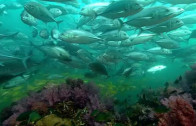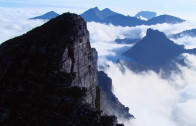The Blue Planet
The Blue Planet is a comprehensive series of films about the natural history of the world’s oceans. Each film in the series examines a different aspect of marine life—from the Arctic and Antarctica, to the depths of wide open oceans and coral reefs, to the coastlines and tides of the Galápagos Islands, Russia, Australia, Argentina and elsewhere.
Series
The first episode looks at how ocean life is regulated around the globe by currents and the varying position of the sun. Near a Pacific seamount, there is a large concentration of marine animals because when the current makes contact with the submerged rock, it forces upwards plankton and other organisms. This in turn attracts other fish to the area that are higher up the food chain, like tuna, and those that are higher still, such as silky sharks. Off South Africa, a similar situation occurs every June when sardines migrate and are pursued by a caravan of various predators. The South Atlantic waters are the roughest, and storms also churn up nutrients to the surface. These feeding grounds have led to the world’s largest albatross breeding colony, on Steeple Jason Island, west of the Falklands. Phytoplankton forms the basis of all sea life, and every night some 1,000 million tonnes of creatures ascend from the deep to search for food. Lunar phases can also have a bearing on events and the mass arrival of Ridley sea turtles on a Costa Rican beach is shown. Herring initiate the most productive food chain, providing sustenance for humpback whales, and Steller’s and California sea lions. In addition, their eggs are nutrition for many, both above and in the sea. Along the coast of California, a migrating gray whale and her calf are targeted by a pod of orcas, who hunt down and kill the calf. Meanwhile another gray whale carcass has sunk to the bottom of the deep sea. Hagfish, a sleeper shark, and other scavengers arrive to feast on the carcass. A year and a half later the carcass is stripped to the bone.
Part two explores the unknown depths of the ocean. Over 60% of the sea is more than a mile deep and it forms the planet’s most mysterious habitat. A sperm whale descends 1,000 metres to look for food and is followed, with the Johnson Sealink submersible. On the way down, a number of unusual creatures are witnessed, such as transparent squid and jellies, whose photophores give pulsating displays of colour. In such dark places, both being able to see or sense movement and the means of quick concealment are equally desirable. To that end, some use bioluminescence as a means of detecting food or evading predators. A descent to the very bottom of the ocean—some 4,000 metres—reveals life even at such cold temperatures, much of it new knowledge.
The third installment focuses on life in the “marine deserts,” seas that are furthest from land. Such waters contain the swiftest and most powerful of ocean hunters. Accumulations of plankton correspond to ocean ‘boundaries’ and consequently, schools of fish seek them out. This in turn attracts predators, and a sailfish is filmed on the attack. The only escape for smaller fish is to put as much distance between them and their pursuers as possible. Bluefin tuna are able to heat their bodies and so can hunt in colder conditions than the others of their species. Off the coast of New Zealand, an undersea volcano has formed an island and the nearby currents sweep many kinds of creatures to it, again creating huge feeding grounds. Another Pacific seamount is surrounded by hammerhead sharks, but not to seek food: they are there to allow other fish to clean them of parasites.
Part four compares oceanic life in the Arctic and Antarctica. The winter in these regions brings temperatures of minus 50°C and frozen seas that create the biggest challenge. However, there are polynyas in the Arctic, which are free of ice owing to the pressure of currents on either side, and such places do provide refuge for some species, like the walrus and the bowhead whale. A pod of belugas is shown. Their movements are limited to a single hole in the ice, therefore putting them at risk of attack from polar bears. Everything changes with the arrival of summer, when melting ice brings a variety of migratory visitors. At the other end of the planet, in the Antarctic, winter is even more harsh, but emperor penguins and Weddell seals stay throughout. Under the sea ice, krill shrink in size and revert to their juvenile form in order to save energy. Chinstrap penguins overwinter to the north, beyond the ice, but return during the spring to breed. Having managed to get ashore, they have to walk a great distance to find a nest site, and the most favoured is Zavodovski Island, an active volcano whose warmth keeps ice from forming. Further south, as the sea ice breaks up, humpback and minke whales appear.
This programme surveys the effects of the seasons on the world’s temperate seas. Sable Island near Nova Scotia boasts the largest colony of grey seals, which breed there when the weather is at its worst. The pups remain marooned for weeks until the spring, when they are strong enough to swim. Spring also heralds the bloom of phytoplankton: it provides food for copepods, and they in turn are prey to jellyfish, which assemble in vast, million-strong swarms. On the Californian coast, giant kelp also flourishes and by summer, grows at the rate of a metre a day. It provides a sanctuary for shoals of fish and sea otters, the latter anchoring themselves to the seaweed when resting and keeping its grazers in check by eating them. Late summer in Alaska sees Pacific salmon heading inshore to breed.
This episode follows coral reefs which are so crowded that they play host to a perpetual battle for space, even among the coral itself. It starts life as a larva that becomes a polyp. Having multiplied, it hardens into a limestone skeleton and grows to form a reef. As the community flourishes, animals develop relationships with one another and such a place can feature a huge variety of ocean life. Although corals feed nocturnally on plankton, sunlight is vital because even though they are animals, each contains millions of single-celled algae. This in turn is the favoured sustenance of the humphead parrotfish, whose jaws are so powerful that it erodes much of the reef into fine sand. Algae also grows on the top of the reef and a battle for grazing rights between shoals of powder blue and convict tangs is shown, the former being initially overwhelmed by the latter’s weight of numbers before regaining the upper hand. The night-time hunting of a marbled ray alerts other predators and a group of whitetip reef sharks moves in, from which few are safe. Several breeding strategies are examined, including the acrobatic habits of brown surgeonfish and the colourful courtship of the flamboyant cuttlefish.
Part seven shows marine life that are structured around the rising and falling tides. These are caused by the gravitational pull of the moon, but in some locations, this can also combine with the power of the sun to create a tidal bore. The world’s largest tides are to be found in the Bay of Fundy in Nova Scotia and therefore it is a rich area of diversity.
The final programme examines the world’s coastal environments—the most dynamic of all ocean habitats. The perils of living in such places are highlighted by Marine Iguanas on the Galápagos Islands, whose diet of seaweed is quickly grabbed between crashing breakers. Many shores provide sites in which to breed or lay eggs. Apart from birds, turtles are among other major species to do so, and the mass emergence of flatbacks on Crab Island in Australia is reduced by predatory herons, pelicans and other hunters. Each year, four million seabirds, comprising fourteen species, return to the island of Talan in eastern Russia to nest. By ensuring that all their chicks eventually leave at the same time, they lessen the impact of predators. The rough seas of the Southern Ocean play host to penguins, and a group of them is shown being pursued by an aggressive bull sea lion. The planet’s coldest seas are in Antarctica, and on South Georgia each spring, thousands of Southern elephant seals arrive to breed. In Patagonia, the social nature of sea lions is shown as they establish colonies, each of them several hundred strong. While in some respects it is an ideal location for the growing young, high tide brings danger for the colony as a pod of orcas habitually goes on the attack.




